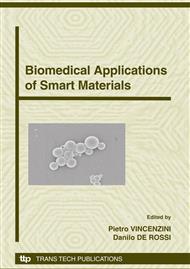p.204
p.210
p.216
p.220
p.226
p.235
p.241
p.247
p.257
Fatigue Properties of Superelastic Ti-Ni Filaments Used in Braided Cables for Bone Fixation
Abstract:
Superelastic 0.1mm diameter Ti-Ni filaments are used to manufacture braided orthopedic cable for bone fixation. Biomechanical conditions for this application generally have a cyclic nature, and therefore it becomes important to evaluate the influence of the installation (mean) strain on the fatigue life of these filaments. Uniaxial tension cyclic testing of Ti-Ni filaments is performed in a water bath at 37°C with a 2Hz frequency of to 100 000 cycles. Strain-controlled testing conditions are as follows: alternating strain magnitude varies between 0.64 and 3.64% with mean strain range between 1.32 and 7.1%. Based on the premises that the minimum strain should be high enough to prevent any loss of tension in the tested specimen and that the maximum strain should not bring the specimen to failure during the first loading cycle, the total strain magnitude is encompassed between 0.68 and 8.94%. The results obtained provide a better understanding of the impact mean strain has on the fatigue life of superelastic Ti-Ni alloys.
Info:
Periodical:
Pages:
235-240
Citation:
Online since:
September 2008
Authors:
Keywords:
Price:
Сopyright:
© 2008 Trans Tech Publications Ltd. All Rights Reserved
Share:
Citation:


